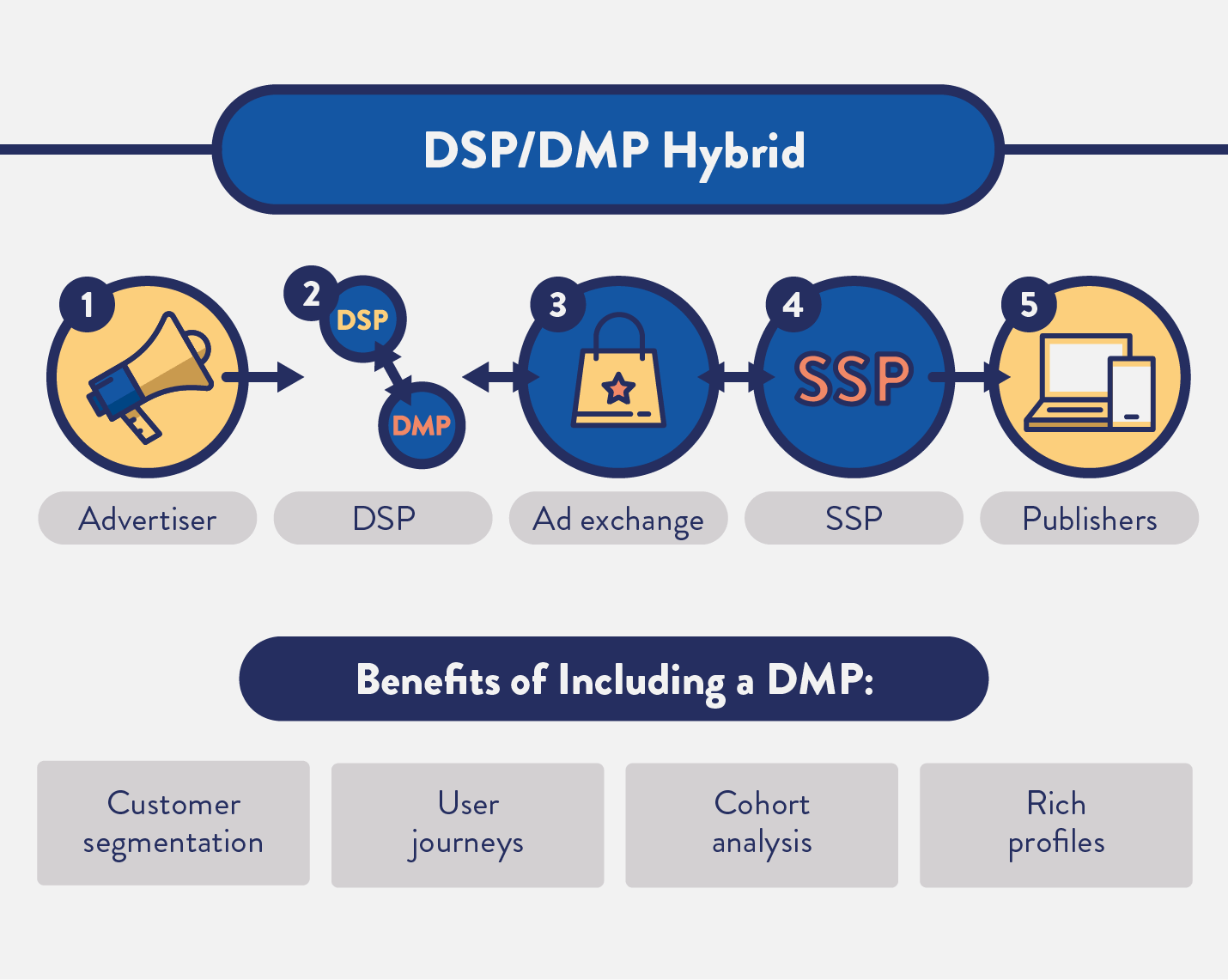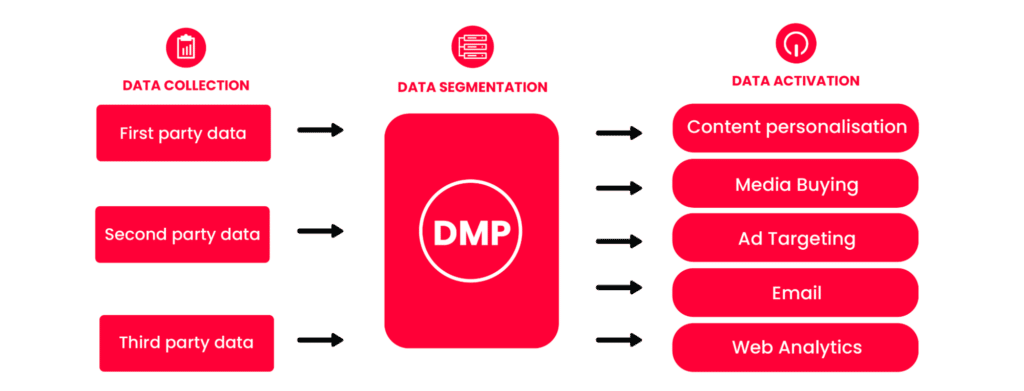7 min to read
Integrating DSP and DMP for Enhanced B2B Targeting

For us, integrating Demand-Side Platforms (DSPs) and Data Management Platforms (DMPs) has been a strategic move to enhance our B2B targeting capabilities. This integration allows us to streamline the ad buying process while utilising rich data insights for more precise targeting.
A DSP enables us to purchase advertising space efficiently, ensuring that we can place ads in front of the right audience at the optimal time. Meanwhile, a DMP collects and manages data from various sources, including first-party data from our websites and third-party data, providing us with detailed insights into audience behaviours and preferences.
By integrating these two platforms, we can leverage the detailed segmentation data from the DMP to inform our ad purchases on the DSP. This synergy enables us to target very specific B2B audiences with tailored messages.
You could work with us, the leading digital marketing agency in Lisbon, Portugal.
Demand-Side Platforms (DSPs)
A DSP is a type of software used by advertisers to buy advertising in an automated fashion. DSPs are crucial for accessing a wide range of inventory across multiple exchanges and allow advertisers to manage multiple ad exchanges and data exchange accounts through one interface. The primary role of a DSP is to enable advertisers to purchase ad space efficiently, ensuring that they can target specific audiences at scale. DSPs facilitate the bidding process in real-time, automating the purchase of display, video, mobile, and search ads.
Key Functions of DSPs:
Automated Buying: DSPs automate the buying of digital ad space using real-time bidding (RTB) technology.
Targeting: They offer advanced targeting options based on geography, demographics, device type, and more.
Optimization: DSPs optimise campaigns based on performance data, helping advertisers achieve the best possible ROI.
Data Management Platforms (DMPs)
A DMP is a technology platform used for collecting and managing data, primarily for digital advertising purposes. It gathers and organises data from multiple sources (e.g., from DSPs, SSPs, websites, and other first, second, and third-party sources) and provides a centralised platform for advertisers to create target audiences based on collected data. This data can then be used to tailor marketing messages to specific segments.
Key Functions of DMPs:
Data Collection: DMPs aggregate data from various sources including first-party data (from the advertiser’s own systems), second-party data (from partnerships), and third-party data (purchased from outside data providers).
Audience Segmentation: They help advertisers segment their audience more effectively, allowing for more precisely targeted advertising campaigns.
Data Integration: DMPs integrate with DSPs to enable advertisers to use the detailed audience data for real-time ad targeting across various platforms.
Connecting DSPs and DMPs:
While DSPs focus on the buying of ad spaces through automated systems and optimising the ad placements, DMPs are focused on managing and understanding the vast amounts of data used to make those buying decisions more targeted and efficient. By connecting DMPs with DSPs, advertisers can leverage the rich audience insights generated by DMPs to execute highly targeted and effective ad campaigns through DSPs. This synergy allows for the sophisticated personalization of marketing efforts, which is critical in today’s digital advertising ecosystem.
DSPs and DMPs communicate and share data.

In digital advertising, Demand-Side Platforms (DSPs) and Data Management Platforms (DMPs) play critical roles, and the way they communicate and share data is central to executing targeted and efficient ad campaigns.
A DMP collects and organises data from various sources like websites, mobile apps, and CRM systems. This data is then segmented into different categories based on demographics, behaviours, or interests, creating detailed profiles of users. These segments can include information like age groups, geographic locations, browsing behaviours, or purchase history.
Once these segments are established, the DMP then integrates with a DSP. This integration is typically achieved via APIs (Application Programming Interfaces), which allow for seamless data transfer between systems. The DMP sends these detailed user segments to the DSP. The DSP then uses this data to make real-time bidding decisions on ad inventories that match the defined audience segments. When an ad impression becomes available that fits a segment's criteria, the DSP can automatically place bids in real-time, considering factors such as the user's likelihood of engagement based on the DMP-provided data.
For instance, if a DSP is targeting a campaign for a sports brand, the DMP can provide data segments of users who have recently looked at sports equipment online or frequently visit sports-related websites. With this targeted data, the DSP can more effectively bid on ad spaces that these users are likely to see, significantly increasing the chances of engagement and conversion.
This technical orchestration between DSPs and DMPs enables advertisers to leverage vast amounts of data to target ads more precisely, optimise their ad spend, and improve overall campaign performance. It's a powerful example of how technology is used to enhance marketing efficiency in the digital age.
Integrating DSP and DMP with data synchronisation and system configuration

We approach the integration of DSP and DMP by first ensuring that both platforms can communicate effectively. This means configuring the DMP to collect and segment data accurately from various sources, including web analytics, CRM systems, and third-party data providers. The DMP then organises this data into actionable segments that can be targeted specifically based on customer behaviour and preferences.
Once the data is segmented, it's synchronised with the DSP. This synchronisation allows the DSP to execute targeted advertising campaigns based on the rich, segmented data provided by the DMP. For instance, if the DMP identifies a segment of users interested in high-end electronics based on their browsing behaviour and past purchases, the DSP can then target this segment with specific ads on digital platforms where these users are most likely to engage.
For effective integration, we also focus on the technical setup, which includes API integration between the DSP and DMP. This setup ensures that data flows continuously and updates in real time, allowing for dynamic ad placement and optimization based on the latest user data and campaign performance metrics.
The result of this integration at CodeDesign has been a marked improvement in campaign ROI. Campaigns are more targeted, waste fewer resources, and deliver ads that are more likely to convert, based on real-time data-driven insights. This approach not only enhances the effectiveness of individual campaigns but also improves the overall strategic marketing capabilities of our clients.
For businesses looking to achieve similar results, the key advice would be to invest in robust system integration and ensure continuous data flow between your DSP and DMP. This will allow for more sophisticated and responsive marketing strategies that can dynamically adjust to changes in user behaviour and market conditions.
Real-time data flow between DSP and DMP allows immediate campaign
A DSP is used to purchase advertising inventory in real-time, while a DMP collects and manages data from various sources, providing insights about the audience. The integration of these two platforms allows for a seamless flow of information, where the DMP supplies the DSP with up-to-date audience data, enhancing the targeting accuracy of ad placements.
For example, consider a campaign we ran for a retail client during a high-traffic holiday season. Using the DMP, we gathered data on user behaviours, such as products viewed and time spent on specific pages, along with demographic information. This data was then fed into the DSP in real-time, allowing us to adjust our bidding strategy and creative messaging instantly based on the latest audience insights.
The result was a dynamic advertising campaign that could adapt to changes in consumer behaviour immediately. For instance, if we noticed a surge in interest in a particular product category, we could increase our ad spend on those products instantly, maximising the relevance of the ads and improving the click-through rates and conversions.
This real-time responsiveness is critical, especially during fast-paced events or shopping seasons, as it helps to capitalise on trends as they occur, rather than reacting after the fact. The ability to make immediate adjustments based on fresh data leads to more efficient spending, better user engagement, and ultimately, superior campaign performance. For other companies looking to achieve similar results, the key advice would be to ensure their DSP and DMP are well integrated and capable of handling real-time data to make swift and strategic decisions during campaigns.
DMPs allow deeper segmentation based on professional data

At CodeDesign, leveraging Data Management Platforms (DMPs) has been transformative, particularly in enabling deeper segmentation based on professional data, behavioural insights, and predictive analytics. This technology allows us to craft finely tuned campaign strategies tailored to specific audience segments.
For example, we utilised a DMP to gather and analyse data from various sources, including website interactions, customer profiles, and purchasing behaviour. This comprehensive view enabled us to identify distinct customer segments, such as tech-savvy young professionals interested in digital marketing tools, or small business owners looking for cost-effective advertising solutions.
By understanding these segments deeply, we were able to design highly personalised marketing campaigns. For instance, for the tech-savvy professionals, we focused on content and ads that highlighted the latest innovations in digital marketing, such as AI-driven analytics and automation tools. Meanwhile, for small business owners, our campaigns emphasised affordability, value for money, and ease of use.
The results were clear: campaigns became more effective, with a notable increase in engagement rates and conversion. Specifically, conversion rates improved by approximately 25% after implementing segmented, data-driven strategies. This success demonstrates the power of DMPs in enhancing marketing efficiency and effectiveness by delivering the right message to the right audience at the right time.

About Bruno GavinoBruno Gavino is the CEO and partner of Codedesign, a digital marketing agency with a strong international presence. Based in Lisbon, Portugal, with offices in Boston, Singapore, and Manchester (UK) Codedesign has been recognized as one of the top interactive agencies and eCommerce agencies. Awarded Top B2B Company in Europe and Top B2C company in retail, Codedesign aims to foster personal relationships with clients and create a positive work environment for its team. He emphasizes the need for digital agencies to focus on data optimization and performance to meet the increasingly results-driven demands of clients. His experience in digital marketing, combined with a unique background that includes engineering and data, contributes to his effective and multifaceted leadership style. |

About CodedesignCodedesign is a digital marketing agency with a strong multicultural and international presence, offering expert services in digital marketing. Our digital agency in Lisbon, Boston, and Manchester enables us to provide market-ready strategies that suit a wide range of clients across the globe (both B2B and B2C). We specialize in creating impactful online experiences, focusing on making your digital presence strong and efficient. Our approach is straightforward and effective, ensuring that every client receives a personalized service that truly meets their needs. Our digital agency is committed to using the latest data and technology to help your business stand out. Whether you're looking to increase your online visibility, connect better with your audience, get more leads, or grow your online sales. For more information, read our Digital Strategy Blog or to start your journey with us, please feel free to contact us. |
CodeDesign is leading:
- Digital Agency
- Digital Marketing Agency
- Digital Ecommerce Agency
- Amazon Marketing Agency



Add comment ×